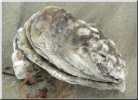|
Eastern Oysters
were once abundant in Barnegat Bay. Due to
over harvesting and disease their numbers have
been significantly reduced.
|
|
Oysters
Anatomy
Lifecycle
Why the decline
Disease
Comeback
Not in a month
without an "R"
|
|
Eastern Oyster
Crassostrea virginica |
|
Jonathan Swift,
the author of Gulliver's Travels, is quoted as
saying:
“He was a bold man that first eat an oyster”
It’s a mystery as
to when people first began eating oysters.
Most likely, they witnessed an animal such as an
otter opening and eating, what at first
glance, looked like a rock.
Whatever the
origins, people have valued oysters as a food
source since recorded history.
Particularly
prized by early Greek and Roman cultures,
oysters are exceptionally nutrient-rich foods
that contain protein and carbohydrates. |
|
 The
eastern oyster is a bivalve mollusk with rough
shells that vary in color from grayish to white. The
eastern oyster is a bivalve mollusk with rough
shells that vary in color from grayish to white.
The shell of the
eastern oyster is thick, flattened, and highly
variable in shape. It grows from round
(irregular) to oval and usually bears concentric
ridges. The exterior color of the shell is dirty
white to gray.
<Click on image to
enlarge> |
|
Unlike
clams, oysters do not dig themselves into the
bay bottom for protection. They require a
hard surface to attach to. This is where
they will spend the rest of their lives. |
|

Juvenile oysters
(also called spat) attach themselves (with a glue-like
substance) to rocks, shell or other
oysters.
After time, this
accumulation of oysters and shell forms a reef.
These reefs not only provide an environment for
future generations of oysters but for a habitat
for many different species of animals.
Fish such as
blennies and gobies, grass shrimp, snails,
barnacles, mussels, flatworms and crabs to name
a few.
The smaller
animals in turn become food for larger animals
such as flounder and weakfish.
(everybody benefits)
<Click on image to
enlarge> |
|
What happened to
the oyster population in Barnegat Bay
<click here> |
|
Disease problems for oysters
<click here> |
|
Oyster returning to Barnegat Bay
|
|
Why do they say don't eat oysters in months
without an R (May June July August)
<click here> |
|
|
